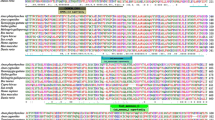Abstract
The dopamine D1 receptor (DRD1), a member of the dopamine receptor (DR) gene family, participates in the regulation of reproductive behaviors in birds. In this study, a 1,390 bp fragment covering the complete coding region (CDS) of duck DRD1 gene was obtained. The cDNA (GenBank: JQ346726) contains a 1,353 bp CDS and a 37 bp 3′- UTR including a TGA termination codon (nucleotides 1,354–1,356 bp). The duck DRD1 shares about 76–96 % nucleic acid identity and 82–98 % amino acid identity with their counterparts in other species. A phylogenetic tree based on amino acid sequences displays that duck DRD1 protein is closely related with those of chicken and zebra finch. The quantitative real-time PCR analysis indicates that the DRD1 mRNA is widely expressed in all examined tissues. Five single nucleotide polymorphisms (SNPs) (c.189A > T, c.507C > T, c.681C > T, c.765A > T, c.1044A > G) in the CDS of duck DRD1 gene were indentified, c.681C > T and c.765A > T were genotyped and analyzed in a two generations duck population by using of PCR–RFLP. Association analysis demonstrated that the c.681C > T genotypes were significantly associated with body weight at sexual maturity (when laying their first egg) (P < 0.01), egg production within 360 days (P < 0.05) and 420 days (P < 0.01); the c.765A > T genotypes were significantly associated with egg shape index and egg shell strength (P < 0.05). Those results suggest that the DRD1 gene may be a potential genetic marker to improve some reproductive traits in ducks.





Similar content being viewed by others
References
Missale C, Nash SR, Robinson SW, Jaber M, Caron MG (1998) Dopamine receptors: from structure to function. Physiol Rev 78:189–225
Porter TE, Grandy D, Bunzow J, Wiles CD, Civelli O, Frawley LS (1994) Evidence that stimulatory dopamine receptors may be involved in the regulation of prolactin secretion. Endocrinology 134:1263–1268
Youngren OM, Pitts GR, Phillips RE, el Halawani ME (1995) The stimulatory and inhibitory effects of dopamine on prolactin secretion in the turkey. Gen Comp Endocrinol 98:111–117
Youngren OM, Pitts GR, Phillips RE, el Halawani ME (1996) Dopaminergic control of prolactin secretion in the turkey. Gen Comp Endocrinol 104:225–230
Youngren OM, Chaiseha Y, Al-Zailaie K, Whiting S, Kang SW, El Halawani M (2002) Regulation of prolactin secretion by dopamine at the level of the hypothalamus in the turkey. Neuroendocrinology 75:185–192
Kebabian JW, Calne DB (1979) Multiple receptors for dopamine. Nature 277:93–96
Gingrich JA, Caron MG (1993) Recent advances in the molecular biology of dopamine receptors. Annu Rev Neurosci 16:299–321
Al Kahtane A, Chaiseha Y, El Halawani M (2003) Dopaminergic regulation of avian prolactin gene transcription. J Mol Endocrinol 31:185–196
Xu HP, Shen X, Zhou M, Fang MX, Zeng H, Nie QH, Zhang XQ (2010) The genetic effects of the dopamine D1 receptor gene on chicken egg production and broodiness traits. BMC Genet 11:17
Zhang LC, Ning ZH, Xu GY, Hou ZC, Yang N (2005) Heritabilities and genetic and phenotypic correlation of egg quality traits in brown-egg dwarf layers. Poult Sci 84:1209–1213
Joseph S, David WR (2002) In: Huang PT (ed) Molecular cloning a laboratory manual, 3rd edn. Science Press, Beijing
Edgar RC (2004) MUSCLE: multiple sequence alignment with high accuracy and high throughput. Nucleic Acids Res 32:1792–1797
Tamura K, Dudley J, Nei M, Kumar S (2007) MEGA4: molecular evolutionary genetics analysis (MEGA) software version 4.0. Mol Biol Evol 24:1596–1599
Zhang CL, Wang Y, Chen H, Lan XY, Lei CZ (2007) Enhance the efficiency of single-strand conformation polymorphism analysis by short polyacrylamide gel and modified silver staining. Anal Biochem 365:286–287
Sharp PJ, Macnamee MC, Sterling RJ, Lea RW, Pedersen HC (1988) Relationship between prolactin LH and broody behavior in bantam hens. J Endocrinol 118:279–286
Reddy IJ, David CG, Sarma PV, Singh K (2002) The possible role of prolactin in laying performance and steroid hormone secretion in domestic hen. Gen Comp Endocrinol 127:249–255
Cui JX, Du HL, Liang Y, Deng XM, Li N, Zhang XQ (2006) Association of polymorphisms in the promoter region of chicken prolactin with egg production. Poult Sci 85:26–31
Liu HG, Wang XH, Liu YF, Zhao XB, Li N, Wu CX (2007) Analysis of the relationship between codon frequency of prolactin gene and laying performance in five chicken breeds. Progress in Biochemistry and Biophysics 34:1101–1106 abstract in English
Jiang RS, Zhang LL, Geng ZY, Yang T, Zhang SS (2009) Single nucleotide polymorphisms in the 5’-flanking region of the prolactin gene and the association with reproduction traits in geese. S Afr J Anim Sci 39:83–87
Wang C, Liang ZH, Yu WH, Feng YP, Peng XL, Gong YZ, Li SJ (2011) Polymorphism of the prolactin gene and its association with egg production traits in native Chinese ducks. S Afr J Anim Sci 41:63–69
Monsma FJ Jr, Mahan LC, McVittie LD, Gerfen CR, Sibley DR (1990) Molecular cloning and expression of a D1 dopamine receptor linked to adenylyl cyclase activation. Proc Natl Acad Sci 87:6723–6727
Fremeau RT Jr, Duncan GE, Fornaretto MG, Dearry A, Gingrich JA, Breese GR, Caron MG (1991) Localization of D1 dopamine receptor mRNA in brain supports a role in cognitive, affective, and neuroendocrine aspects of dopaminergic neurotransmission. Proc Natl Acad Sci 88:3772–3776
Duan J (2003) Synonymous mutations in the human dopamine receptor D2 (DRD2) affect mRNA stability and synthesis of the receptor. Hum Mol Genet 12:205–216
Acknowledgments
The authors thank Dr Xiangdong Liu and Ming Xiong for helping on the statistical analysis. This research was supported by the Project of Scientific Research and Development in Hubei Province (2011BBB096), the National Natural Science Foundation of China (31172201), Fundamental Research Funds for the Central Universities (2011QC006), and the Creative Team Project of Ministry of Education of China (IRT-0831).
Author information
Authors and Affiliations
Corresponding author
Rights and permissions
About this article
Cite this article
Wang, C., Li, S., Li, C. et al. Molecular cloning, expression profile, polymorphism and the genetic effects of the dopamine D1 receptor gene on duck reproductive traits. Mol Biol Rep 39, 9239–9246 (2012). https://doi.org/10.1007/s11033-012-1797-3
Received:
Accepted:
Published:
Issue Date:
DOI: https://doi.org/10.1007/s11033-012-1797-3




